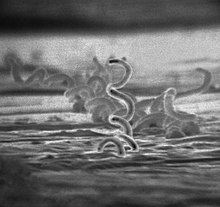Meningeal syphilis
| Meningeal syphilis | |
|---|---|
 | |
| Treponema pallidum 01 | |
| Specialty | Infectious diseases |
Meningeal syphilis (as known as syphilitic aseptic meningitis or meningeal neurosyphilis) is a chronic form of
Early symptomatic neurosyphilis (or acute syphilitic meningitis or neurorecurrence) is the onset of meningeal syphilis. The symptoms arise as a result of inflamed meninges, which eventually lead up to signs of meningitis.[2]
Treponema pallidum invades the
Signs and symptoms

Asymptomatic
- asymptomatic invasion of the central nervous system by Treponema is common within a few months of primary infection[citation needed]
General symptoms of meningeal syphilis
- symptoms of meningitis can occur at any time after the infection
- however, it usually appears within two years
- symptoms may include headache, stiff neck, cranial nerve palsies, convulsions, and mental confusion
- patient is afebrile[1]
General symptoms of neurosyphilis
- Personality change
- Ataxia
- Stroke
- Visual Impairment
- Bladder incontinence
- Hearing Loss
- Seizures
- Headache
General signs of neurosyphilis

- Hyporeflexia
- Sensory impairment
- Dementia
- Mania
- Charcot Joint
- Hypotonia
- Optic Atrophy
- Argyll Robertson pupil[1]
- Argyll Robertson pupil constricts with accommodation but it is not reactive to light
- This sign is usually evident in the tertiary stage of syphilis
Clinical features
The types of neurosyphilis include asymptomatic, acute syphilitic meningitis, meningovascular syphilis, parenchymatous syphilis (which includes general paresis and tabes dorsalis), and optic atrophy.[5]
Anatomy of disease

This fluid circulates through the brain and spinal cord, and it is produced in the
Pathophysiology

Stages of disease
The four main stages of syphilis are the primary, secondary, latent, and tertiary stages:
Primary stage
The first sign of syphilis can occur during the first few weeks of exposure. This exposure in particular is caused by the
Secondary stage

The secondary stages of syphilis persists to be more dangerous to the systems of the human body. The disseminated disease can cause
Latent stage
The latent stage is the asymptomatic stage, which includes two phases. The two phases of the asymptomatic stage include early (within one year of exposure and infection) and late(after one year of exposure and infection). In this stage, the bacteria can remain inactive for three to thirty years, and it may not progress to the tertiary stage of syphilis, which is the final stage. This stage is highly dangerous because the symptoms altogether disappear and remain hidden for a prolonged period of time. The diagnosis of this stage is positive serology.[10] Because the bacteria remains inactive, the late latent syphilis does not spread and is noninfectious.[citation needed]
Tertiary stage
The tertiary stage is known as the final stage of syphilis or "late" syphilis. This deadly stage starts after three years of exposure and infection to syphilis. Typically, the person is no longer contagious with the disease, but the gram-negative bacteria in the body can reactivate, reproduce, multiply, and spread drastically throughout the body. At this point, the infection spreads to all the systems in the human body, including the nervous system, bones, eyes, and heart. Neurosyphilis at this point can cause several damages to the body, including
Diagnosis

There are several methods to diagnose meningeal syphilis. One of the most common ways include visualizing the
Cerebrospinal fluid (CSF) findings
- Pressure may be normal or raised
- Fluid is clear
- Protein is elevated (100–200 mg%)
- Sugar is normal
- Cell count is elevated and is lymphocytic
- Gamma globulin levels are elevated
- VDRL and TPHA (Treponema pallidum haemagglutination) are positive[2]
Prevention
There are many different forms on prevention of syphilis and other
Treatment

Penicillin
The most popular treatment forms for any type of syphilis uses penicillins, which have been effective treatments used since the 1940s.[15] Other forms also include
Jarisch-herxheimer reaction
The
It is important to realize that syphilis can recur. An individual who has had the disease once, even if it has been treated, does not prevent the person from experiencing recurrence of syphilis. Individuals can be re-infected, and because syphilis sores can be hidden, it may not be obvious that the individual is infected with syphilis. In these cases, it is vital to become tested and treated immediately to reduce spread of the infection.[citation needed]
